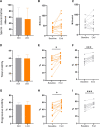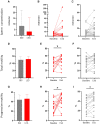Improvements in Sperm Motility Following Low- or High-Intensity Dietary Interventions in Men With Obesity
- PMID: 37656983
- PMCID: PMC10795917
- DOI: 10.1210/clinem/dgad523
Improvements in Sperm Motility Following Low- or High-Intensity Dietary Interventions in Men With Obesity
Abstract
Introduction: Obesity increases risks of male infertility, but bariatric surgery does not improve semen quality. Recent uncontrolled studies suggest that a low-energy diet (LED) improves semen quality. Further evaluation within a randomized, controlled setting is warranted.
Methods: Men with obesity (18-60 years) with normal sperm concentration (normal count) (n = 24) or oligozoospermia (n = 43) were randomized 1:1 to either 800 kcal/day LED for 16 weeks or control, brief dietary intervention (BDI) with 16 weeks' observation. Semen parameters were compared at baseline and 16 weeks.
Results: Mean age of men with normal count was 39.4 ± 6.4 in BDI and 40.2 ± 9.6 years in the LED group. Mean age of men with oligozoospermia was 39.5 ± 7.5 in BDI and 37.7 ± 6.6 years in the LED group. LED caused more weight loss than BDI in men with normal count (14.4 vs 6.3 kg; P < .001) and men with oligozoospermia (17.6 vs 1.8 kg; P < .001). Compared with baseline, in men with normal count total motility (TM) increased 48 ± 17% to 60 ± 10% (P < .05) after LED, and 52 ± 8% to 61 ± 6% (P < .0001) after BDI; progressive motility (PM) increased 41 ± 16% to 53 ± 10% (P < .05) after LED, and 45 ± 8% to 54 ± 65% (P < .001) after BDI. In men with oligozoospermia compared with baseline, TM increased 35% [26] to 52% [16] (P < .05) after LED, and 43% [28] to 50% [23] (P = .0587) after BDI; PM increased 29% [23] to 46% [18] (P < .05) after LED, and 33% [25] to 44% [25] (P < .05) after BDI. No differences in postintervention TM or PM were observed between LED and BDI groups in men with normal count or oligozoospermia.
Conclusion: LED or BDI may be sufficient to improve sperm motility in men with obesity. The effects of paternal dietary intervention on fertility outcomes requires investigation.
Keywords: male fertility; male reproduction; obesity; sperm quality; spermatogenesis; weight loss.
© The Author(s) 2023. Published by Oxford University Press on behalf of the Endocrine Society.
Figures




References
-
- World Health Organization (WHO) . International Classification of Diseases, 11th Revision (ICD-11). WHO; 2018.
-
- Human Fertilisation and Embryology Authority . Published online 2013. Accessed December 12, 2022. www.hfea.gov.uk.
-
- Ombelet W, Campo R. Affordable IVF for developing countries. Reprod Biomed Online. 2007;15(3):257‐265. - PubMed
-
- Papanikolaou N, Luo R, Jayasena CN. Fertility considerations in hypogonadal men. Endocrinol Metab Clin North Am. 2022;51(1):133‐148. - PubMed
Publication types
MeSH terms
Grants and funding
LinkOut - more resources
Full Text Sources
Medical

